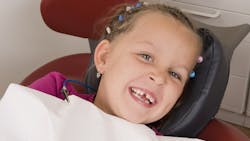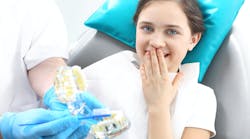Using tell-show-do as a valuable tool for pediatric patients
Summertime is usually one of my favorite times of the year: It means beach vacations, theme parks, warmer weather, new music, and of course, seeing more children patients.
Yes, I said it! When I was in corporate dentistry, one of the things that I actually looked forward to in the summer is seeing more of my pediatric patients. Most parents have the opportunity during summer break to bring their children to dental offices because it relieves the burden of missing school hours and rearranging work schedules to accommodate dental appointments during the school year.
With nothing but pediatric patients on my schedule every day, I feel comfortable and equipped for these fun, youthful patients. I am fully confident that all dental hygienists can be efficient, amazing pediatric dental hygienists too. Because remember: if you have even seen just one child patient, you can proudly acknowledge yourself as a pediatric dental hygienist too. Awesome—wear it as a badge of honor! How exciting that as pediatric dental hygienists, we can all embrace a great opportunity to provide quality care, excellent oral health education, and an incredible dental experience to our younger infants, toddlers, teenagers, and special-needs patients.
The biggest tool that I have in my equipment bag for being a great pediatric hygienist is super simple and (unfortunately) underused, it is the tell-show-do method. The amazing fact about this reliable method is we all have access to a productive process that can result in a very rewarding experience for our young patients. This method is often forgotten, but we should use this method as frequently as we can with our patients from children to young adults. The tell-show-do method can be quickly and effectively broken down to use every day with your pediatric patients within most of your steps of your prophy appointment, without wasting time and efficiency. It is possible with these tips.
Introducing yourself
Tell-show-do starts from the beginning of the appointment to the very end. Once the child is in the operatory, with or without a parent/guardian, instantly make them feel at home with friendly smiles and enthusiasm. Ask patients about school, family, and activities they enjoy, while telling and showing them fun facts about yourself or even your day. If the child is willing, always allow them to sit in the chair independently and make them feel comfortable. If the child proves to be extremely anxious or unruly, always encourage a quiet room. If that is not possible, allow the parent or guardian to sit in the operatory. Immediately start with the tell-show-do method and guide the parent with the proper parental assistance to treat the child safely. The most important person in the operatory is the patient.
Radiographs
A great way to explain the importance of radiographs is acknowledging to the pediatric patient that “teeth pictures” are taken to assure that their teeth stay healthy and strong. Show the child the lead apron by demonstrating how it fits on yourself first while making the patient aware that this “blanket” called a lead apron will be placed on them. When taking radiographs, constantly show the patient the sensor or film that is made of plastic and how easy it is to bite on. To prevent gag reflexes as effectively as possible, placement always begins with a song, dance, or fun major distraction with quick, easy-to-follow instructions and ends with a game of “Freeze” to keep the patient still. The goal is to have fun while moving efficiently.
Operatory chair
As the chair is being reclined back during a prophy appointment, hand the patient fun protective eyewear to wear and always acknowledge that the chair is going to move so that their teeth can be brushed fast and well. Add plenty of clever, fun spins, such as saying “up, up, and away,” when the chair goes up and “I am going to lay you back like you are relaxing on a beach or laying down in a bed,” as the chair is reclined backwards. Remember to always reaffirm that you will show them everything and that they can do it!
Tray setup
Oftentimes, hygienists will cover the tray under a patient napkin or tuck it on a counter far away until a child prophy appointment begins. It is important to acknowledge the tray setup to build rapport and allow the patient to know what will happen next. A great time to quickly run through tray setup is while the pediatric patient is being seated in the chair or being reclined back. If the child is tolerant of it, make them aware of any instruments in sight and explain that teeth are small, and small instruments are sometimes needed to touch and clean their teeth.
I introduce my items in a friendly, energetic way, constantly reminding and reassuring the patient that cleaning their teeth is easy and can be done in a few steps. It is a good rule of thumb to move quickly and efficiently while explaining the tray setup. By the time I have explained the tray setup, I have already laid the patient back in the chair, placed the patient napkin, and have readied myself for the prophy appointment.
Handpieces and flossing
I always allow the patient to feel the prophy angle as it spins on the handpiece, demonstrating to the patient that my “power toothbrush” is soft and tickly. If there are flavor options, allow the patient to feel like they are in control of their appointment by choosing their flavor prophy paste and fluoride.
Flossing is demonstrated by using a small sample of floss and instructing the child patient to hold their hands out with fingers wide. While running in between their fingers with the floss, I show patients that the floss will go in between their teeth, just like their fingers. “Your teeth will jump rope over the floss,” is one of my favorite sayings I added from a fellow hygienist.
Air/water syringe and suction
While demonstrating the handpiece and flossing techniques, use the opportunity to show the child the air/water syringe and suction. Mention that the air/water syringe and tip is a “cool water gun” that squirts water and air, while squirting water in the patient’s mouth or on the tray and blowing air on their hand. Quickly follow up with the suction by telling the child that the suction (“Mr. Thirsty” or any creative name you have for suction) is like a straw that sucks all the water away. I demonstrate that by asking the patient to close their lips on the “straw” or simply suck water out of a disposable cup for them to observe.
With the tell-show-do method, you don’t need to dread a summer full of pediatric patients!
Editor's note: Originally published July 2021. Updated April 2024.
Michele Brock Brown, MPH, RDH, is a licensed/registered public health pediatric dental hygienist for the states of South Carolina and Georgia. For six years, her primary experience has been treating children, teenagers, and young adults with Medicaid and other government assistance. Michele enjoys treating pediatric patients, special needs patients, and patients with extreme fear and anxiety. Michele currently works in public health dentistry with a mobile dental unit that primarily treats pediatric patients at elementary, middle, and high schools.
About the Author
Michele Brock Brown, MPH, RDH
Michele Brock Brown, MPH, RDH, is a licensed/registered public health pediatric dental hygienist for the states of South Carolina and Georgia. For six years, her primary experience has been treating children, teenagers, and young adults with Medicaid and other government assistance. Michele enjoys treating pediatric patients, special needs patients, and patients with extreme fear and anxiety. Michele currently works in public health dentistry with a mobile dental unit that primarily treats pediatric patients at elementary, middle, and high schools.

